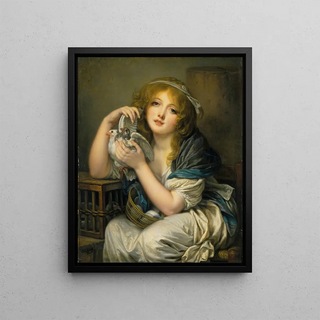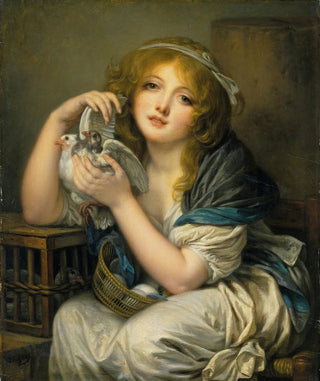Art print | Woman with doves - Jean-Baptiste Greuze


View from behind

Frame (optional)
Art print Femme aux colombes - Jean-Baptiste Greuze – Engaging Introduction
In the vibrant universe of 18th-century art, the work "Femme aux colombes" by Jean-Baptiste Greuze stands out for its brilliance and emotional depth. This painting, which evokes both tenderness and delicacy, transports the viewer into a world where beauty and human sensitivity meet. Observing this piece, one is immediately struck by the harmony of colors and the finesse of details, revealing a snapshot of everyday life imbued with poetry. The woman depicted, surrounded by doves, embodies natural grace, symbolizing both love and peace. This image, far more than a simple representation, is a true tableau of the human soul, inviting reflection on emotional relationships and the fragility of beauty.
Style and uniqueness of the work
Greuze's style is characterized by meticulous attention to emotions and character expressions. In "Femme aux colombes," the softness of the woman's face, with her delicate features and gaze filled with tenderness, immediately captures attention. The doves, symbols of peace and love, add an extra dimension to the composition, creating a dialogue between man and nature. The subtly orchestrated light illuminates the face of the protagonist while creating soft shadows that enhance the scene's three-dimensionality. The color palette, composed of pastel tones and warm shades, evokes a serene, almost ethereal atmosphere. Greuze manages here to marry realism with poetic idealization, giving his work a singularity that still resonates today.
The artist and his influence
Jean-Baptiste Greuze, an emblematic figure of the Rococo movement, was able to capture the essence of his era while forging a style unique to him. Born in 1725, he was influenced by the masters of French painting, while developing a distinctive approach that prioritizes human emotions. Greuze distinguished himself through his ability to tell stories through his portraits and genre scenes, touching the hearts of the public. His contribution to art is not limited to his

Matte finish

View from behind

Frame (optional)
Art print Femme aux colombes - Jean-Baptiste Greuze – Engaging Introduction
In the vibrant universe of 18th-century art, the work "Femme aux colombes" by Jean-Baptiste Greuze stands out for its brilliance and emotional depth. This painting, which evokes both tenderness and delicacy, transports the viewer into a world where beauty and human sensitivity meet. Observing this piece, one is immediately struck by the harmony of colors and the finesse of details, revealing a snapshot of everyday life imbued with poetry. The woman depicted, surrounded by doves, embodies natural grace, symbolizing both love and peace. This image, far more than a simple representation, is a true tableau of the human soul, inviting reflection on emotional relationships and the fragility of beauty.
Style and uniqueness of the work
Greuze's style is characterized by meticulous attention to emotions and character expressions. In "Femme aux colombes," the softness of the woman's face, with her delicate features and gaze filled with tenderness, immediately captures attention. The doves, symbols of peace and love, add an extra dimension to the composition, creating a dialogue between man and nature. The subtly orchestrated light illuminates the face of the protagonist while creating soft shadows that enhance the scene's three-dimensionality. The color palette, composed of pastel tones and warm shades, evokes a serene, almost ethereal atmosphere. Greuze manages here to marry realism with poetic idealization, giving his work a singularity that still resonates today.
The artist and his influence
Jean-Baptiste Greuze, an emblematic figure of the Rococo movement, was able to capture the essence of his era while forging a style unique to him. Born in 1725, he was influenced by the masters of French painting, while developing a distinctive approach that prioritizes human emotions. Greuze distinguished himself through his ability to tell stories through his portraits and genre scenes, touching the hearts of the public. His contribution to art is not limited to his






